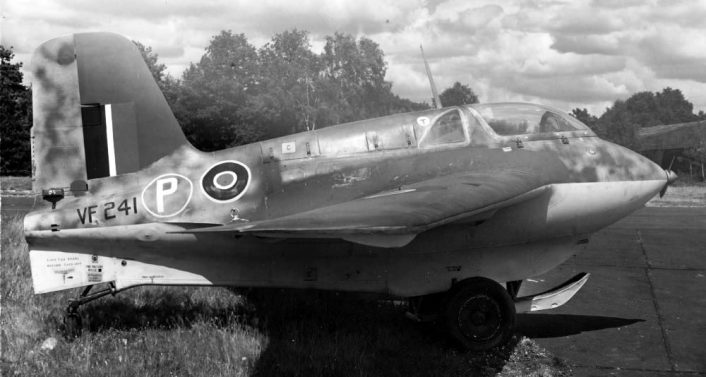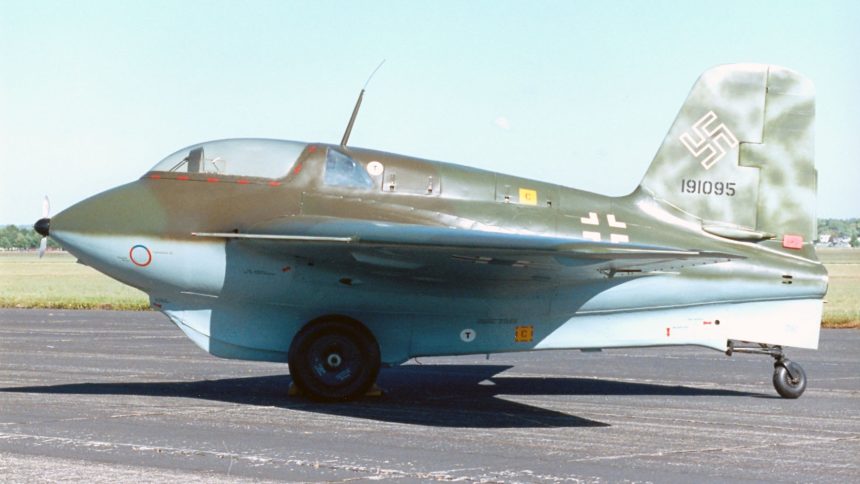Dangerous to Allied bombers as well as the ground crews that maintained it and the pilots that flew it, the tiny Me 163 had an amazing climb rate and top speed thanks to its unique rocket engine propulsion.
Project X
Dr. Alexander Lippisch had been experimenting on tailless sailplane designs for the German Research Institute for Sailplanes (Deutschen Forschungsinstitut für Segelflug) or DFS, when he was approached by Dr. Lorenz of the research department of the RLM (Reichsluftahrtministerium) or German Air Ministry. Dr. Lorenz requested Lippisch design a tailless aircraft for the testing of Hellmuth Walter’s R I-203 rocket motor. Lippisch had already studied the idea of a rocket-propelled aircraft in the 1920’s, and agreed to the idea. The project was labeled Project X.
Lippisch designed a small, light, and tailless aircraft with swept wings, completing the design in March of 1938. The plan was for DFS to construct the wooden wings of the aircraft and for Ernst Heinkel to be subcontracted to build the metal fuselage. However, issues arose in working with Heinkel and Lippisch went to work for Messerschmitt taking the project and his team with him on Jan. 2, 1939. Labeled the DFS 194, the airframe was also moved over to Messerschmitt’s facility. It was now all wood instead of the planned wood wings/metal fuselage construction.
Walter’s rocket motor was fitted to the DFS 194 after the aircraft transferred to Peenemünde-Karlshagen in 1940. Walter’s R I-203 rocket motor produced 882 lb. of thrust using fuels consisting of T-Stoff (80% hydrogen peroxide along with a stabilizer of either oxyquinoline or phosphate) and Z-Stoff (Calcium permanganate). Z-Stoff was a benign liquid; however T-Stoff was highly unstable and highly corrosive. It could burn away human flesh in seconds and was also destructive to copper, lead, and most organic materials, as it decomposed it generated heat similar to ignited gunpowder. This made maintenance, fueling, and flying the aircraft dangerous activities.
The diminutive aircraft had a wingspan of 34’ 9” and a length of 21’. Heini Dittmar was the test pilot and, despite the aircraft having a very limited fuel capacity and being of all wood construction it was not designed to take the speed of the rocket motor, reached 342 mph in the aircraft and realized its climb rate was exceptional.
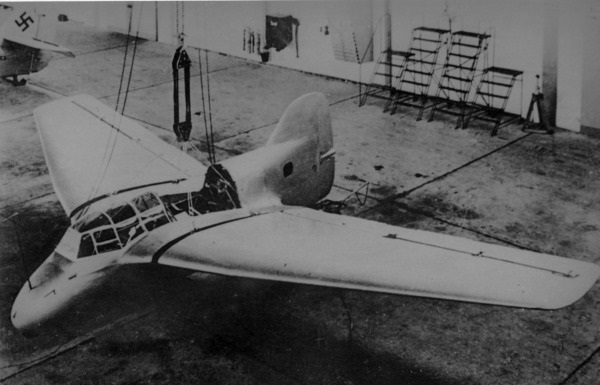
The Me 163A
The results of the DFS 194 experiments resulted in a renewed interest in the Messerschmitt Me 163 project that had been on the backburner in order to produce much needed front-line fighter aircraft such as the Bf 109. Walter had since developed a newer version of his rocket motor with increased thrust, and Dr. Lippisch went to work on completing an operational Me 163.
The first prototype, the Me 163A V1 was completed during the winter of 1940-41, tested with gliding trials in the spring of 1941. The Me 163 would be towed aloft, using the Messerschmitt Bf-110 twin-engine aircraft. The Me 163 had no fixed landing gear, instead relying on a dolly that was soon jettisoned after takeoff and recovered. An extendable and retractable skid was used for landing. The Me 163A was also a small aircraft like its predecessor, with a wingspan of 30’ 7” and length of 18’ 4”. The wings were swept at 27 degrees at the leading edge root increasing out to 32 degrees; again it was a tailless all-wing design. The aircraft weighed 5,291 lb loaded. Test pilot Dittmar was able to determine the aircraft had extraordinary flying characteristics in the non-powered tests.
Between July and October of 1941, the Komet, fitted with Walter’s improved R II-203b rocket motor producing 1,635 lb of thrust, flew powered trials at Peenemünde. Dittmar was breaking world speed records with ease, and soon reached speeds of 500 mph and up to 550 mph. The aircraft accelerated so fast that it would actually run out of fuel due to the limited fuel capacity and the 4.5 minutes of flying time before reaching maximum speed, limiting the aircraft to around 570 mph. Dittmar had the aircraft fueled and towed to 13,120 ft and, after release from the towing Bf 110, he fired the rocket motor. Having more fuel in the tanks as a result of not having to take-off and climb to altitude, the Me 163 reached 623.85 mph when it suddenly went into a dive as a result of compressibility effects. Dittmar recovered the aircraft after cutting the rocket motor. Problems with wingtip stall and issues with the reliability of the rocket motor and propellants would need to be worked out.
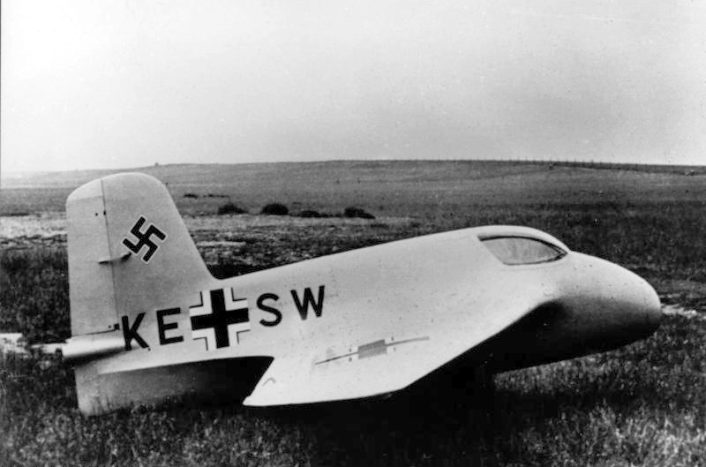
The Me 163B
The speeds and performance demonstrated by the Me 163A generated excitement and Lippisch was challenged to produce an armed interceptor version of the aircraft with greater fuel capacity, flight time, and powered by a redesign of the rocket motor.
The new rocket motor, the R II-211, would now use a different catalyst known as C-Stoff, which was a 30 percent hydrazine hydrate solution in methanol, in place of the unsatisfactory Z-Stoff. Rated at 3,750 lb of thrust, the new motor had difficulties during development once again. As previously, the aircraft would be forced to conduct unpowered flights.
Completed in the summer of 1942, the Me 163B V2 demonstrated exceptional flying characteristics as well. Unpowered tests included a drag chute to slow the aircraft in an emergency and allow the pilot to escape the cockpit, and improved landing flaps were also tested. During the landing flaps testing, a severe injury occurred to test pilot Dittmar when the aircraft dropped from about 12 ft onto the concrete below in a windless space behind a hanger. The impact injured Dittmar’s spine and put him in the hospital. The unpowered tests continued; testing everything possible until the rocket motor could be installed.
In July 1943, the R II-211 rocket motor arrived and was installed in Me 163B V2. The first powered flight of the Me 163B that August would be an adventurous one, with the wheeled dolly detaching during take-off before the aircraft was airborne, forcing test pilot Rudolf Opitz to continue the launch on the landing skid. The aircraft did finally become safely airborne, only to have the cockpit fill with T-Stoff steam. Burning off the limited fuel that was loaded for the test flight, Opitz was able to land safely despite having impaired vision. Opitz would go on to suffer similar injuries as Dittmar, from the same test aircraft hitting too hard upon landing when the landing skid failed to extend. The result of the two men’s injuries was a new seat with a torsion spring being installed in all standard production Me 163B aircraft.
Other specifications of the B model included the wingspan staying at 30’ 7”, length was now 19’ 2”, empty weight was 4,200 lb and maximum loaded weight was 9,500 lb. The aircraft was just over 9 feet tall. Climb rate was 16,000 ft per minute, with a service ceiling of 39,500 ft. With an endurance of 7.5 minutes the Komet could reach speeds of close to 600 mph. The production version of the rocket motor would now be known as the HWK 109-509A. Issues arose with the engine cutting off when leveling off from a climb due to safety measures installed in order to prevent the two volatile fuels from accidentally mixing. Modifications helped reduced these incidents, but never seemed to fully resolve them. A small propeller in the nose of the aircraft drove a generator.
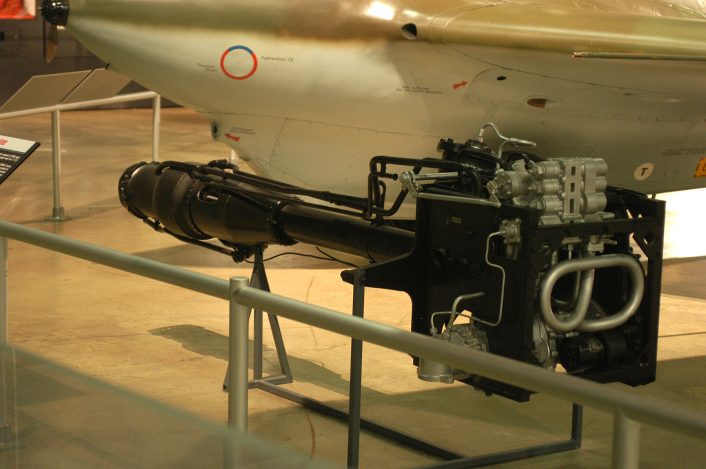
Initial armament consisted of two MK 151 20 mm cannon installed in the wing roots, but these were changed to the MK 108 30 mm cannon in the production aircraft, now designated the Me 163B-1a, with the first being accepted into the Luftwaffe (German Air Force) in May 1944. The idea was that the aircraft would now be used to intercept Allied bombers. The aircraft carried 60 rounds of 30 mm per gun. However, the MK 108 was a rather slow firing weapon at 450 rounds per minute with a range of about 650 yards and a muzzle velocity of just 1,600 feet per second, and the Komet was a fast moving aircraft, and hitting one of the also moving bombers with the cannon while avoiding ramming the target was a challenge.
The search for better armament resulted in the creation of the Jagdfaust, which consisted of mounting five vertical firing tubes in each wing root. The firing tubes each contained a 50 mm shell. The tubes were activated by a photocell sensor that fired the tubes at the detection of a passing shadow of an aircraft above the Me 163. The idea was to fly under bomber formations and when the sensor was triggered, a salvo of the 50 mm shells would fire upwards and destroy the bombers. Only one Boeing B-17 was destroyed with this unconventional weapon.
Rocket Results
While a bold and advanced design, the Me 163 didn’t have a stellar combat record. Requiring precise construction and maintenance techniques, it had many teething problems. In addition the combustibility of the fuels when combined made fueling, flying and especially landing with any fuel onboard a dangerous proposition. Any accidents that would cause the fuels to combine meant a deadly explosion. Around 370 Komets were built, and it is thought they are responsible for the downing of less than 20 allied aircraft. Ten Me-163s were lost in combat and many casualties occurred as a result of the hazardous fuels, despite suits made with asbestos being issued to both pilots and ground crew.
Many improved versions were in the works; a glider/trainer version was created by removing fuel tanks and adding a tandem seat, known as the Me 163S. An Me 163C with improved endurance, relocation of the armaments to the fuselage, and a bubble canopy was also designed. The Me 163D with retractable tricycle landing gear was in the works, but the war soon ended. Continuing with the tailless rocket-propelled design, the Me 263 was also in the planning stages towards the end of the war.
The Germans shared the design with their Japanese allies, and although the actual pattern aircraft never made it to Japan, the manual did. The Japanese would design the aircraft from the manual and Yokosuka would build the rocket motor. Known as the Mitsubishi Ki-200 by the Japanese Army or J8M1 as it was known by the Japanese Navy, the Shusui (religious sword) first flew in July 1945 but was destroyed when the motor failed. Others in production were too late as the war soon ended. An example of this aircraft is on display at the Planes of Fame Air Museum in Chino, California.
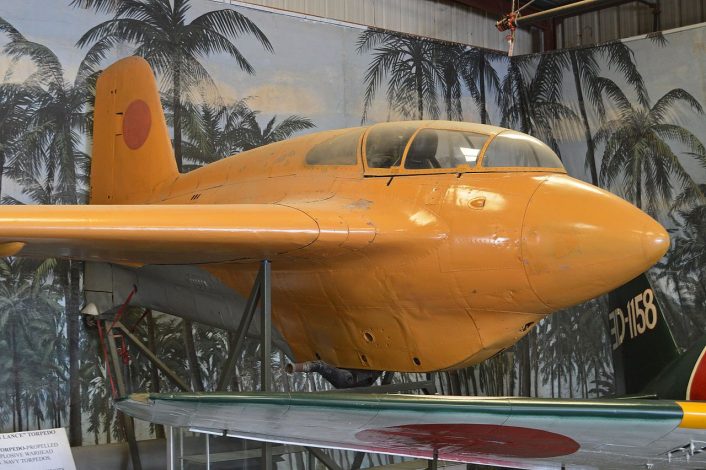
Captured Komets
Many nations of the victorious Allies received captured Me 163 Komets at war’s end. The United States, Soviet Union, United Kingdom, and France studied the idea of rocket power interceptors and developed prototypes, but none ever entered service. Several Komets are housed in museums today, and one replica non-powered glider has been constructed, as well as static replicas.
